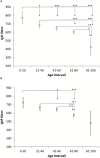Francisella tularensis- specific antibody levels in sera from Swedish patients with suspected tularemia during a 13-year period
- PMID: 38628552
- PMCID: PMC11018962
- DOI: 10.3389/fcimb.2024.1381776
Francisella tularensis- specific antibody levels in sera from Swedish patients with suspected tularemia during a 13-year period
Abstract
Introduction: For a majority of tularemia patients, serology is the basis for the diagnosis. The aim of this study was to perform an analysis of the samples analyzed at a Swedish reference laboratory for the presence of Francisella tularensis-specific antibody levels in sera from individuals with suspected tularemia. Annual and monthly variations of the total number of samples and proportions of positive samples were analyzed, as well as the influence of age and gender.
Methods: We performed a retrospective analysis of the presence of F. tularensis-specific antibodies in serological samples from patients with suspected tularemia analyzed during the period 2010 - 2022 at the University Hospital of Umeå in Sweden, a national reference laboratory, by use of various statistical methods. In total, some 15,100 serum samples had been analyzed for the presence of IgG and IgM antibodies by ELISA during the 13-year period.
Results: Overall, there were higher number of samples with IgG positive or borderline titers, 2,522 and 921, respectively, than with IgM positive or borderline titers, 1,802 and 409, respectively. Repeated samples were obtained from some 1,930 individuals and approximately a third of the cases, which were initially seronegative, had seroconverted when resampled. Peak number of monthly samples were recorded in August and September, > 3,000. Annual numbers varied greatly and peak numbers were observed in 2015 and 2019, 1,832 and 2,250, respectively, whereas some other years the numbers were 700 - 800. There was also much variation in the annual and monthly percentages of positive samples and they varied between less than 10% to greater than 20%. The highest percentages of positive samples were recorded in September and October. IgG and IgM titers declined with age and these differences were highly significant for IgG titers, with decreasing average titers for each 20-year interval.
Discussion: Collectively, the data demonstrate the marked annual and seasonal variations in tularemia sampling occurring in Sweden. Also, the proportion of positive samples increased during months and years with peak number of samples. Another notable finding was that average antibody titers decreased with increased age.
Keywords: age-related titers; annual distribution; monthly distribution; serological response; tularemia.
Copyright © 2024 Lindgren, Liu and Sjöstedt.
Conflict of interest statement
The authors declare that the research was conducted in the absence of any commercial or financial relationships that could be construed as a potential conflict of interest.
Figures





Similar articles
-
Kinetics of the serological response up to one year after tularemia.Front Cell Infect Microbiol. 2023 Jan 6;12:1072703. doi: 10.3389/fcimb.2022.1072703. eCollection 2022. Front Cell Infect Microbiol. 2023. PMID: 36683705 Free PMC article.
-
Enzyme-linked immunosorbent assay for immunological diagnosis of human tularemia.J Clin Microbiol. 1979 Nov;10(5):615-21. doi: 10.1128/jcm.10.5.615-621.1979. J Clin Microbiol. 1979. PMID: 120873 Free PMC article.
-
Evaluation of In-House and Commercial Serological Tests for Diagnosis of Human Tularemia.J Clin Microbiol. 2017 Dec 26;56(1):e01440-17. doi: 10.1128/JCM.01440-17. Print 2018 Jan. J Clin Microbiol. 2017. PMID: 29118164 Free PMC article.
-
The development of tools for diagnosis of tularemia and typing of Francisella tularensis.APMIS. 2004 Nov-Dec;112(11-12):898-907. doi: 10.1111/j.1600-0463.2004.apm11211-1212.x. APMIS. 2004. PMID: 15638842 Review.
-
Francisella tularensis, Tularemia and Serological Diagnosis.Front Cell Infect Microbiol. 2020 Oct 26;10:512090. doi: 10.3389/fcimb.2020.512090. eCollection 2020. Front Cell Infect Microbiol. 2020. PMID: 33194778 Free PMC article. Review.
Cited by
-
Development of a novel sandwich immunoassay based on targeting recombinant Francisella outer membrane protein A for the diagnosis of tularemia.Front Cell Infect Microbiol. 2024 Aug 20;14:1455259. doi: 10.3389/fcimb.2024.1455259. eCollection 2024. Front Cell Infect Microbiol. 2024. PMID: 39228894 Free PMC article.
References
MeSH terms
Substances
LinkOut - more resources
Full Text Sources

